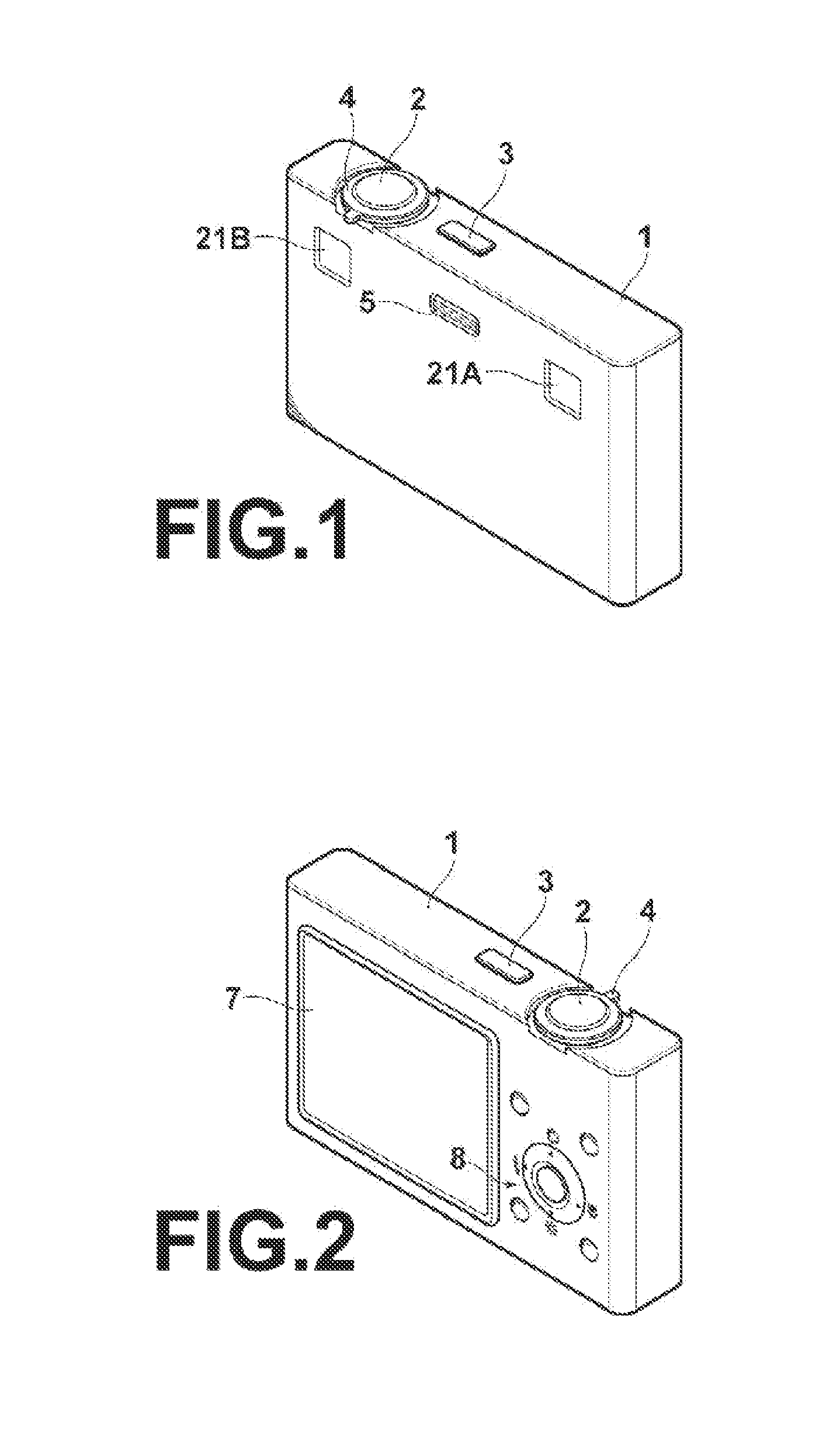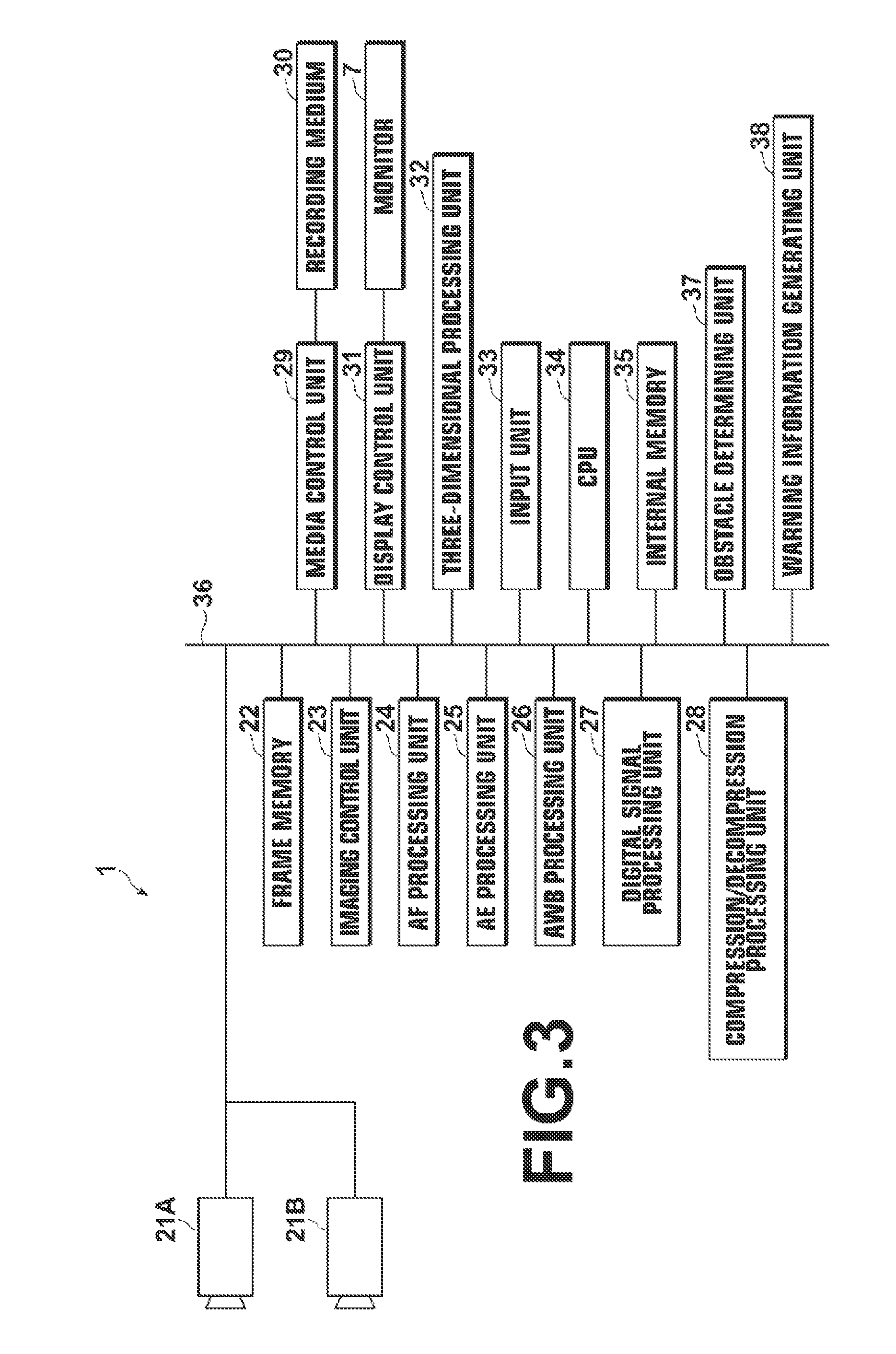Device, method and program for determining obstacle within imaging range during imaging for stereoscopic display
a technology of determining method and imaging range, which is applied in the field of devices, methods and programs for determining obstacles within imaging range during imaging for stereoscopic display, can solve the problems of only applicable determining method, operator viewing live-view image cannot recognize, and is not easy to visually recognize, so as to achieve higher and more stable accuracy, the effect of higher accuracy and higher accuracy
- Summary
- Abstract
- Description
- Claims
- Application Information
AI Technical Summary
Benefits of technology
Problems solved by technology
Method used
Image
Examples
first embodiment
[0132]FIG. 15 is a flow chart illustrating the flow of a process carried out in the invention. First, when the half-pressed state of the release button 2 is detected (#1: YES), the preliminary images G1 and G2 for determining imaging conditions are obtained by the imaging units 21A and 21B, respectively (#2). Then, the AF processing unit 24, the AE processing unit 25 and the AWB processing unit 26 perform operations to determine various imaging conditions, and the components of the imaging units 21A and 21B are controlled according to the determined imaging conditions (#3). At this time, the AE processing unit 25 obtains the photometric values IV1 (i,j), IV2 (i,j) of the individual areas in the imaging ranges of the imaging units 21A and 213.
[0133]Then, at the obstacle determining unit 37, the index value obtaining unit 37A obtains the photometric values IV1 (i,j) IV2 (i,j) of the individual areas (#4), the area-by-area differential value calculating unit 37B calculates the differen...
second embodiment
[0150]As described above, in the invention, the mean index value calculating unit 37F combines the areas divided at the time of photometry, and calculates the mean photometric value of each combined area. Therefore, an error due to a parallax between the imaging units is diffused by combining the areas, thereby reducing erroneous determinations.
[0151]It should be noted that, in this embodiment, the index values (photometric values) of the combined areas are not limited to mean values of the index values of the areas before combined, and may be any other representative value, such as a median value.
[0152]In a third embodiment of the invention, among the areas IV1 (i,j), IV2 (i,j) at the time of photometry in the first embodiment, areas around the center are not counted.
[0153]Specifically, in step #7 of the flowchart shown in FIG. 15, the area counting unit 37D counts the number CNT of areas having absolute values |ΔIV (i,j)| of the differential values between the photometric values o...
third embodiment
[0156]the invention, as described above, uses a fact that an obstacle always enters the imaging range from the marginal areas thereof. By not counting the central areas, which are less likely to contain an obstacle, of each imaging range when the photometric values are obtained and the determination as to whether or not there is an obstacle is performed, the determination can be achieved with higher accuracy.
[0157]In a fourth embodiment of the invention, the AF evaluation values are used as the index values in place of the photometric values used in the first embodiment. Namely, operations in the fourth embodiment are the same as those in the first embodiment, except that, in step #4 of the flow chart shown in FIG. 15, the index value obtaining unit 37A in the block diagram shown in FIG. 11 obtains the AF evaluation values, which are obtained by the AF processing unit 24, of the individual areas in the imaging ranges of the imaging units 21A and 21B.
[0158]FIG. 22A shows one example ...
PUM
 Login to View More
Login to View More Abstract
Description
Claims
Application Information
 Login to View More
Login to View More - R&D
- Intellectual Property
- Life Sciences
- Materials
- Tech Scout
- Unparalleled Data Quality
- Higher Quality Content
- 60% Fewer Hallucinations
Browse by: Latest US Patents, China's latest patents, Technical Efficacy Thesaurus, Application Domain, Technology Topic, Popular Technical Reports.
© 2025 PatSnap. All rights reserved.Legal|Privacy policy|Modern Slavery Act Transparency Statement|Sitemap|About US| Contact US: help@patsnap.com



